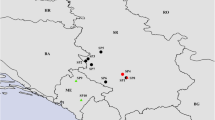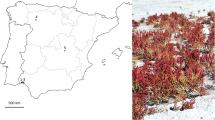Abstract
The objective of this study was to determine eco-edaphic characteristics and influence of different substrates on mineral characteristics of facultative serpentinophyte. The total concentration of 20 elements Al, As, B, Ca, Cd, Co, Cr, Cu, Fe, K, Li, Mg, Mn, Na, Ni, P, Pb, S, Se, and Zn in soil samples and aboveground parts of medicinal plant species Teucrium montanum from various calcareous and serpentinite habitats in the territory of Serbia was determined. The concentration of the elements was established by inductively coupled plasma optical emission spectrometry–ICP-OES. The obtained results showed that the quantities of certain elements Al, As, B, Ca, Cd, Cu, K, Li, P, Se, and Zn were detected more in the soil samples from calcareous habitats in comparison to the quantities of other metals Co, Cr, Fe, Mg, Mn, Na, Ni, which were more frequently found in the soil samples from the serpentinite habitats. Analyzed plant samples from calcareous habitats contained higher concentrations of Al, Ca, Li, and Zn as opposed to serpentinite containing higher concentrations of Co, Cr, Fe, Mg, Mn, Na, Ni, and Se. Examined species can accumulate macro- and microelements in different quantities, depending on the substrate type. Differences in the concentration of certain elements in the soil samples and aboveground parts of the T. montanum from calcareous and serpentinite habitats indicate significant phenotypic plasticity of the investigated species as well as the existence of specific serpentinite ecotypes developed by the activity of various edaphic factors.





Similar content being viewed by others
References
Alexander, E. B., Coleman, R. G., Keeler-Wolf, T., & Harrison, S. P. (2007). Serpentine geoecology of western North America. New York: Oxford University Press Inc..
Asemaneh, T., Ghaderian, S. M., & Baker, A. J. M. (2007). Responses to Mg/Ca balance in an Iranian serpentine endemic plant, Cleome heratensis (Capparaceae) and a related non-serpentine species, C. foliolosa. Plant and Soil, 293, 49–59.
Ata, S., Farooq, F., & Javed, S. (2011). Elemental profile of 24 common medicinal palnts of Pakistan and its direct link with traditional uses. Journal of Medicinal Plant Research, 5(26), 6164–6168.
Balabanova, B., Stafilov, T., & Bačeva, K. (2015). Bioavailability and bioaccumulation characterization of essential and heavy metals contents in R. acetosa, S. oleraceae and U. dioica from copper polluted and referent areas. Journal of Environmental Health Science & Engineering, 13(2), 1–13.
Baniwal, S. K., Bharti, K., Chan, K. Y., Fauth, M., Ganguli, A., Kotak, S., Mishra, S. K., Nover, L., Port, M., Scharf, K. D., Tripp, J., Weber, C., Zielinskim, D., & Von Koskull Döring, P. (2004). Heat stress response in plants: a complex game with chaperones and more than twenty heat stress transcription factors. Journal of Biosciences, 29(4), 471–487.
Bilings, G. K., & Ragland, P. C. (1968). Geochemistry and mineralogy of the Recent reef and lagoonal sediments south of Belize (British Honduras). Chemical Geology, 3(2), 135–153.
Brady, U. K., Kruckeberg, R. A., & Bradshaw, J. H. D. (2005). Evolutionary ecology of plant adaptation to serpentine soils. Annual Review of Ecology, Evolution, and Systematics, 36, 243–266.
Brooks, R. R. (1987). Serpentine and its vegetation: a multidisciplinary approach. In T. R. Dudley (Ed.), Ecology, phytogeography, and physiology series. Oregon: Dioscorides Press.
Brown, P. H., Dunemann, L., Schultz, R., & Marschner, H. (1989). Influence of redox potential and plant species on the uptake of nickel and cadmium from soils. Journal of Plant Nutrition and Soil Science, 152, 85–91.
Chiarucci, A. (2004). Vegetation ecology and conservation on Tuscan ultramafic soils. The Botanical Review, 69(3), 252–268.
Dong, J., Wu, F. B., Huang, R. G., & Zhang, G. P. (2007). A chromium-tolerant plant growing in Cr contaminated land. International Journal of Phytoremediation, 9(3), 167–179.
Ewald, J. (2003). The calcareous riddle: Why are there so many calciphilous species in the Central European flora. Folia Geobotanica, 38(4), 357–366.
Ghaderian, A. M., Mohtadi, A., Rahiminejad, R., Reeves, R. D., & Baker, A. J. M. (2007). Hyperaccumulation of nickel by two Alyssum species from the serpentine soils of Iran. Plant and Soil, 293, 91–97.
Gonneau, C., Genevois, N., Frérot, H., Sirguey, C., & Sterckeman, T. (2014). Variation of trace metal accumulation, major nutrient uptake and growth parameters and their correlations in 22 populations of Noccaea caerulescens. Plant and Soil, 384, 271–287.
Johnston, W. R., & Proctor, J. (1977). Metal concentrations in plants and soil from two British serpentine sites. Plant and Soil, 46, 275–278.
Kabata-Pendias, A. (2011). Trace elements in soils and plants (4th ed.). New York: CRC Press.
Kastori, R., Kádár, I., & Sekulić, P. (2006). Sampling soil and plants in noncontaminated and contaminated sites. Novi Sad: Institute of Field and Vegetable Crops.
Kastori, R., Ilin, Ž., Maksimović, I., & Putnik-Delić, M. (2013). Potassium in plant nutrition potassium and vegetables. Novi Sad: Faculty of Agriculture of Novi Sad.
Kataeva, M. N., Alexeeva-Popova, N. V., Drozdova, I. V., & Beljaeva, A. I. (2004). Chemical composition of soils and plant species in the polar Urals as influence by rock type. Geoderma Regional, 122(2–4), 257–268.
Kazakou, E., Dimitrakopoulos, P. G., Baker, A. J. M., Reeves, R. D., & Troumbis, A. Y. (2008). Hypotheses, mechanisms and trade-offs of tolerance and adaptation to serpentine soils: from species to ecosystem level. Biological Reviews, 83(4), 495–508.
Kruckeberg, A. R. (1954). The ecology of serpentine, Soli III. Plant species in relation to serpentine soils. Ecology, 35, 267–274.
Kruckeberg, A. R. (1984). California serpentines: Flora, vegetation, geology, soils and management problems. Berkeley: University of California Press.
Lambers, H., Stuart Chapin, F., III, & Pons, L. T. (2008). Plant physiological ecology. New York: Springer.
Lazarus, B. E., Richards, J. H., Claassen, V. P., O'Dell, R. E., & Ferrell, M. A. (2011). Species specific plant-soil interaction influence plant distribution on serpentine soils. Plant and Soil, 342, 327–344.
Lombini, A., Dinelli, E., Ferrari, C., & Simoni, A. (1998). Plant-soil relationships in the serpentine screes of Mt. Prinzera (northern Apennines, Italy). Journal of Geochemical Exploration, 64(1), 19–33.
Marschner, H. (2002). Mineral nutrition of higher plants. New York: Academic Press.
Palit, S., Sharma, A., & Talukder, G. (1994). Effects of cobalt on plants. The Botanical Review, 60(2), 150–181.
Pavlova, D., & Karadjova, I. (2012). Chemical analysis of Teucrium species (Lamiaceae) growing on serpentine soils in Bulgaria. Journal of Plant Nutrition and Soil Science, 175(6), 891–899.
Reboredo, F. H., Pelica, J., Lidon, F. C., Ramalho, J. C., Pessoa, M. F., Calvão, T., Simões, M., & Guerra, M. (2018). Heavy metal content of edible plants collected close to an area of intense mining activity (southern Portugal). Environmental Monitoring and Assessment, 190, 484.
Reeves, R. D., & Baker, A. J. M. (2000). Metal-accumulating plants. In I. Raskin & B. D. Ensley (Eds.), Phytoremediation of toxic metals: Using plants to clean up the environment. New York: John Wiley & Sons, Inc..
Reeves, R. D., Baker, A. J. M., Becquer, T., Echevarria, G., & Miranda, Z. J. G. (2007). The flora and biogeochemistry of the ultramafic soils of Goiás state Brazil. Plant and Soil, 293(1), 107–119.
Robinson, H. B., Brooks, R. R., Kirkman, H. J., Gregg, H. E. P., & Gremigni, P. (1996). Plant available elements in soils and their influence on the vegetation over ultramafic (“serpentine”) rocks in New Zeland. Journal of the Royal Society of New Zeland, 26(4), 457–468.
Šavkin, K. P., Živković, J. C., Zdunić, G. M., Gođevac, D. M., Djorđević, B. S., Dojčinović, B. P., & Đorđević, N. O. (2014). Phenolic and mineral profiles of four Balkan indigenous apple cultivars monitored at two different maturity stages. Journal of Food Composition and Analysis, 35(2), 101–111.
Shah, K., & Nongkynrih, J. M. (2007). Metal hyperaccumulation and bioremediation. Biologia Plantarum, 51(4), 618–634.
Shallari, S., Schwartz, C., Hasko, A., & Morel, J. L. (1998). Heavy metals in soils and plants of serpentine and industrial sites of Albania. Science of the Total Environment, 209(2–3), 133–142.
Stanković, M., Nicifirović, N., Topuzović, M., & Solujić, S. (2011). Total phenolic content, flavonoid concentrations and antioxidant activity, of the whole plant and plant parts extracts from Teucrium montanum L. var. montanum, f. supinum (L.) Reichenb. Biotechnology & Biotechnological Equipment, 25(1), 2222–2227.
Stevanović, V., Tan, K., & Iatrou, G. (2003). Distribution of the endemic Balkan flora on serpentine I.–obligate serpentine endemics. Plant Systematics and Evolution, 242, 149–170.
Stueber, A. M., & Goles, G. G. (1967). Abundances of Na, Mn, Cr, Sc and Co in ultramafic rocks. Geochimica et Cosmochimica Acta, 31(1), 75–93.
Taiz, L., & Zeiger, E. (1998). Plant physiology (2nd ed.). Sunderland: Sinauer.
Tashakor, M., Modabberi, S., van der Ent, A., & Echevaria, G. (2018). Impacts of ultramafic outcrops in Peninsular Malaysia and Sabah on soil and water quality. Environmental Monitoring and Assessment, 190, 333.
Vert, G., Grotz, N., Dédaldéchamp, F., Gaymard, F., Guerinot, M. L., Briat, J. F., & Curie, C. (2002). IRT1, an Arabidopsis transporter essential for iron uptake from the soil and for plant growth. Plant Cell, 14(6), 1223–1233.
Woodruff, L. G., Cannon, W. F., Eberl, D. D., & Smith, D. (2009). Continental-scale patterns in soil geochemistry and mineralogy: results from two transects across the United States and Canada. Applied Geochemistry, 24(8), 1369–1381.
Zlatić, M. N., Stanković, S. M., & Simić, S. Z. (2017). Secondary metabolites and metal content dynamics in Teucrium montanum L. and Teucrium chamaedrys L. from habitats with serpentine and calcareous substrate. Environmental Monitoring and Assessment, 189(3), 110.
Acknowledgments
The authors acknowledge Biljana Dojčinović for assistance with microwave digestion of samples and determination of macro- and microelements by ICP-OES.
Funding
This investigation was supported by Ministry of Science and Technological Development of the Republic of Serbia (III41010).
Author information
Authors and Affiliations
Contributions
Authors equally contributed to the design and implementation of the research, to the analysis of the results, and to the writing of the manuscript.
Corresponding author
Ethics declarations
Competing interests
The authors declare that they have no competing interests.
Additional information
Publisher’s note
Springer Nature remains neutral with regard to jurisdictional claims in published maps and institutional affiliations.
Rights and permissions
About this article
Cite this article
Zlatić, N.M., Stanković, M.S. Effects of calcareous and serpentinite parent material on the mineral characteristics of soils and plant material of Teucrium montanum L. (Lamiaceae). Environ Monit Assess 191, 564 (2019). https://doi.org/10.1007/s10661-019-7750-3
Received:
Accepted:
Published:
DOI: https://doi.org/10.1007/s10661-019-7750-3




